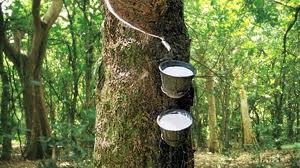The Ghana Rubber Estate Limited (GREL) is to begin the construction of a €50million rubber factory at Agona in the Western Region.
The project, when completed, will create additional 2,000 jobs and increase the production capacity of the rubber producer.
The first phase of the project is scheduled to be completed in 2019 and the final phase in 2028.
The Rubber producer, last year, purchased approximately 19,500 tonnes of dry rubber from over 3,000 farmers in the Western, Ashanti, Eastern and the Central regions.
Frank Kweku Famiyeh, GREL’s Factory Manager, in an interview with B&FT, explained that the factory, since 2012, has seen a significant increase its production capacity.
“Between 2013 and 2014, we increased our install capacity to five tonnes per hour and between 2015 and 2016 we increased it to eight tonnes per hour. So in 2017, we are anticipating to get to 10 tonnes per hour with this present factory.
Per our master plan, that is the final capacity of this existing factory. In terms of machinery and storage, raw materials and finished goods, the site has become congested, so we can’t increase the capacity here again. We are restricted by the size of the site. Because of this, we are initiating a new factory in 2017, the first rubber will come out in 2019,” Mr. Famiyeh said.
Rubber production stood at 18,000 tonnes in 2012; 19,600 tonnes in 2013; 28,754 tonnes in 2014; 30,816 tonnes in 2015; and 36,816 tonnes in 2016. For the 2017 calendar year, the company expects to produce between 40,000 and 41,000 tonnes.
He explained that the company has two sources of raw materials, namely its estate plantation and suppliers from out-growers
“We receive 50% from our estate and 50% from the small holder farmers. The factory processes these rubbers into two main products that has been identified as quality and in line with the international rubber standards at the world market.
So, depending on what is going to be produced, we depend on the ratios, whether 50% from our rubber or 50% from outgrow, or 60, 40% depending on the outcome,” he said.
Rubber is one of the most commonly used plant products in virtually every industry. From tyre industries to aviation, health, education, sports to engineering, rubber is in high demand.
The rubber latex is useful for a wide range of industries and products. It is used for adhesive, insulating, friction tape, crepe rubber used for footwear and insulating blanket. The rubber is also used in aviation tires, hose, and domestic clothes wringers to printing presses.
Rubber latex is used in the manufacture of articles such as cushions, balls, air hoses and balloons. Its ability to resist water and most fluid chemicals has resulted in its use in diving gear, rainwear and chemical and medicinal tubing. It is also used as a lining for railroad tank cars, storage tanks and processing equipment.
There are so many reasons why farmers must engage in rubber farming. Including the huge industrial demand expected to keep the price of rubber high for decades.
It provides high income, high cost of synthetic rubber, low maintenance cost, long period of productivity, has a wide range of adaptability, provides regular income; environment sustainability, high value of rubber wood and allows inter cropping of food and cash crops for higher farm income.
Rubber latex is extracted from rubber trees. The economic life period of rubber trees in plantations is estimated around 35 years with up to 7 years of immature phase and about 25 years of productive phase.
The rubber producing countries in Africa only produce four per cent of the total global production, while Thailand, the largest rubber producer in the world produces 27 per cent.
Ivory Coast, which is the largest producer of rubber in Africa, produces 50 per cent of the total Africa production, while Nigeria produces only 11 per cent with Ghana producing about 19,134 metric tonnes in 2009.
Research has shown that rubber business is more of a smallholder type of business. This is the case in most countries of the world where rubber is planted. It is the smallholders that are more in it than commercial outfits. But the case is different in Ghana as the bulk of production comes from commercial outfits.
As of 2009, approximately 11,855 hectares of land had been cultivated under outgrower schemes financed by the government. The rubber plant has a productive lifespan of 35 years. The country moved from 12,000 hectares of rubber plantations in 1995 to 35,000 hectares, helping to create employment for some 100,000 people.
Rubber production increased from 9,300 metric tonnes in 2000 to 19,134 metric tonnes in 2009, recording an increase of 74 percent over the period.
About 95 percent of the country’s rubber produce is exported to China, France, Turkey, East Africa and South Korea. Ghana also exports to neighbouring Burkina Faso. Currently the traditional rubber-growing regions are the Western and Central Regions, but the northern parts are also being explored for their potential to cultivate the crop.
Strong global economic growth in recent years, especially in the rapidly developing economies of China and India, has increased demand for rubber significantly.
The global demand for natural rubber has been consistently on the rise. Global consumption of natural and synthetic rubber, pegged at 12.3 and 16.8 million tonnes, respectively, in 2015, was an increase of 3.1 percent and 0.9 percent from 2014. It is projected to reach 15 and 19.4 million tonne by 2020.
China, the United States, Japan, India and Germany are the main rubber consumers, accounting for 56.8 percent of global consumption.
Business News of Thursday, 9 March 2017
Source: b&ft.com













